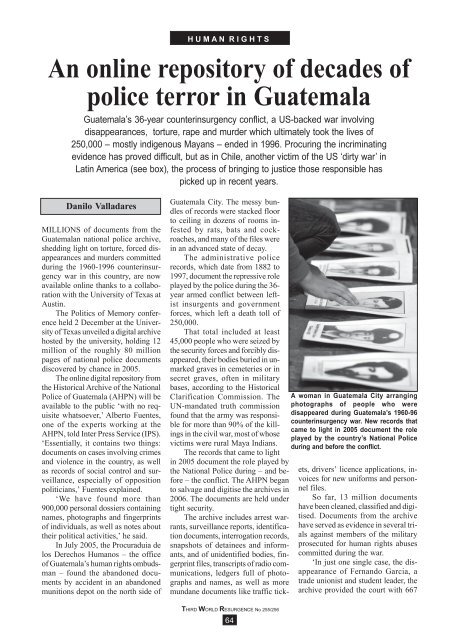Download - Third World Network
Download - Third World Network
Download - Third World Network
You also want an ePaper? Increase the reach of your titles
YUMPU automatically turns print PDFs into web optimized ePapers that Google loves.
H U M A N R I G H T S<br />
An online repository of decades of<br />
police terror in Guatemala<br />
Guatemala’s 36-year counterinsurgency conflict, a US-backed war involving<br />
disappearances, torture, rape and murder which ultimately took the lives of<br />
250,000 – mostly indigenous Mayans – ended in 1996. Procuring the incriminating<br />
evidence has proved difficult, but as in Chile, another victim of the US ‘dirty war’ in<br />
Latin America (see box), the process of bringing to justice those responsible has<br />
picked up in recent years.<br />
Danilo Valladares<br />
MILLIONS of documents from the<br />
Guatemalan national police archive,<br />
shedding light on torture, forced disappearances<br />
and murders committed<br />
during the 1960-1996 counterinsurgency<br />
war in this country, are now<br />
available online thanks to a collaboration<br />
with the University of Texas at<br />
Austin.<br />
The Politics of Memory conference<br />
held 2 December at the University<br />
of Texas unveiled a digital archive<br />
hosted by the university, holding 12<br />
million of the roughly 80 million<br />
pages of national police documents<br />
discovered by chance in 2005.<br />
The online digital repository from<br />
the Historical Archive of the National<br />
Police of Guatemala (AHPN) will be<br />
available to the public ‘with no requisite<br />
whatsoever,’ Alberto Fuentes,<br />
one of the experts working at the<br />
AHPN, told Inter Press Service (IPS).<br />
‘Essentially, it contains two things:<br />
documents on cases involving crimes<br />
and violence in the country, as well<br />
as records of social control and surveillance,<br />
especially of opposition<br />
politicians,’ Fuentes explained.<br />
‘We have found more than<br />
900,000 personal dossiers containing<br />
names, photographs and fingerprints<br />
of individuals, as well as notes about<br />
their political activities,’ he said.<br />
In July 2005, the Procuraduia de<br />
los Derechos Humanos – the office<br />
of Guatemala’s human rights ombudsman<br />
– found the abandoned documents<br />
by accident in an abandoned<br />
munitions depot on the north side of<br />
A woman in Guatemala City arranging<br />
photographs of people who were<br />
disappeared during Guatemala’s 1960-96<br />
counterinsurgency war. New records that<br />
came to light in 2005 document the role<br />
played by the country’s National Police<br />
during and before the conflict.<br />
Guatemala City. The messy bundles<br />
of records were stacked floor<br />
to ceiling in dozens of rooms infested<br />
by rats, bats and cockroaches,<br />
and many of the files were<br />
in an advanced state of decay.<br />
The administrative police<br />
records, which date from 1882 to<br />
1997, document the repressive role<br />
played by the police during the 36-<br />
year armed conflict between leftist<br />
insurgents and government<br />
forces, which left a death toll of<br />
250,000.<br />
That total included at least<br />
45,000 people who were seized by<br />
the security forces and forcibly disappeared,<br />
their bodies buried in unmarked<br />
graves in cemeteries or in<br />
secret graves, often in military<br />
bases, according to the Historical<br />
Clarification Commission. The<br />
UN-mandated truth commission<br />
found that the army was responsible<br />
for more than 90% of the killings<br />
in the civil war, most of whose<br />
victims were rural Maya Indians.<br />
The records that came to light<br />
in 2005 document the role played by<br />
the National Police during – and before<br />
– the conflict. The AHPN began<br />
to salvage and digitise the archives in<br />
2006. The documents are held under<br />
tight security.<br />
The archive includes arrest warrants,<br />
surveillance reports, identification<br />
documents, interrogation records,<br />
snapshots of detainees and informants,<br />
and of unidentified bodies, fingerprint<br />
files, transcripts of radio communications,<br />
ledgers full of photographs<br />
and names, as well as more<br />
mundane documents like traffic tickets,<br />
drivers’ licence applications, invoices<br />
for new uniforms and personnel<br />
files.<br />
So far, 13 million documents<br />
have been cleaned, classified and digitised.<br />
Documents from the archive<br />
have served as evidence in several trials<br />
against members of the military<br />
prosecuted for human rights abuses<br />
committed during the war.<br />
‘In just one single case, the disappearance<br />
of Fernando Garcia, a<br />
trade unionist and student leader, the<br />
archive provided the court with 667<br />
THIRD WORLD RESURGENCE No 255/256<br />
64
















